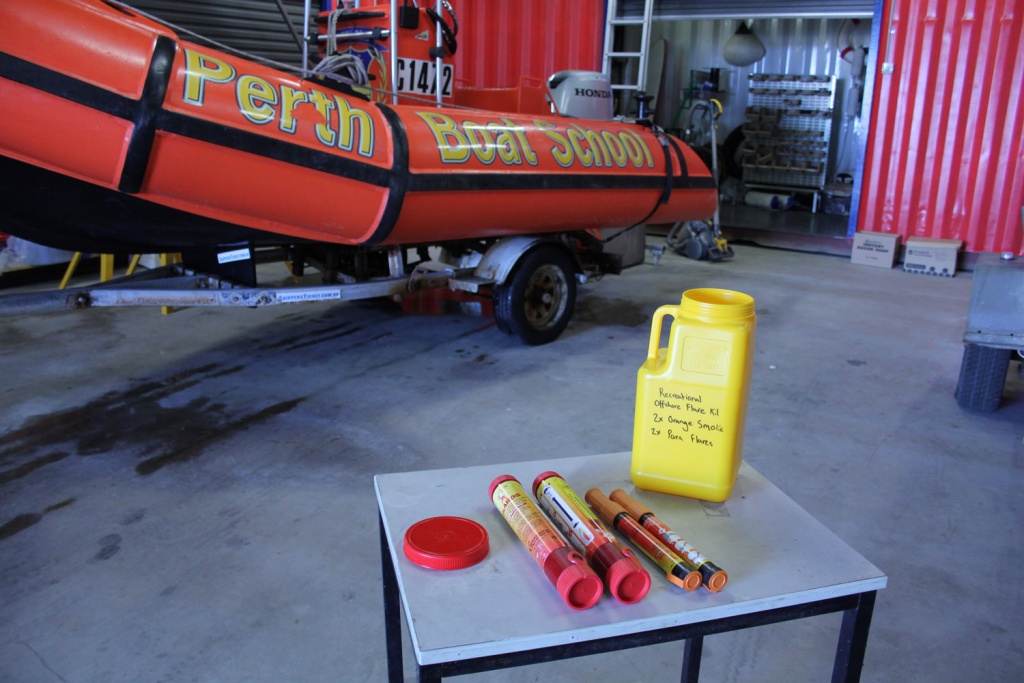Marine Flares:
One of the appeals of boating outside of protected waters is the joy of ‘getting away from it all’. You and your mates are keen for an offshore dive, chasing a few rock lobster for the traditional West Oz Christmas seafood lunch. You’ve had your tanks filled, checked the o-rings on your reg, made sure your go-pro is charged, ensured your rock lobster license is still valid and ensured the esky is full of ice and maybe a couple of post-dive beers for the crew (not the skipper of course). You take your boat down to the ramp, you’ve checked you have enough fuel and that the bungs are in. You launch, you and your mates are stoked and you head off as far from everyone else as you can. After all, you don’t want to be sharing your secret lobster hole.
Safety is important to you so after you’ve dropped anchor at your dive site you do your PADI approved buddy checks, put up your dive flag and then give each other the OK signal before descending. You resurface after your overly cautious safety stop and you all show off your catch and try to upload a couple of shots to Instagram, #oceanhunter #epicday. But there’s no reception…oh well, maybe later.
It’s been a long day on the water and you’re keen to get home…but the boat won’t start. The outboard won’t even crank over…just that awful sound of a relay click. You try again. The safety lanyard is still in. Definitely have fuel left. Click Click…still won’t kick over. You heart sinks and you realise you’re going to have to call sea rescue for a tow. You had forgotten to log on when you left, but no problem, you’ll just jump on the radio. It won’t turn on. Mystery solved. Your battery is dead. Your failed Instagram upload due to no signal sets off an alarm in your head. You’re out of range and you can’t call for help…it’s getting late now and you didn’t even tell anyone on shore you were going for lobsters that day. It was supposed to be a Christmas lunch surprise. That isolation you were seeking earlier in the day is now something that could really ruin your Christmas cheer.
Thankfully you remember your marine flares…
All vessels operating outside of protected waters are required to carry marine flares. Depending on how far offshore you are will determine what kind of flares you must carry. All flares must comply with the Australian Standard AS 2092-2004 or AMSA Marine Orders Part 25.
Marine flares for inshore waters:
In the case of marine safety equipment, inshore unprotected waters are defined as being within 5 nautical miles of the mainland, or within 1 nautical mile from an island situated more than 5 nautical miles from the mainland. In order to lawfully operate a vessel within inshore unprotected waters you must carry:
Two hand-held orange smoke flares OR one orange smoke canister
and
Two hand-held red flares OR two parachute flares
Marine flares for offshore waters:
In the case of marine safety equipment, offshore unprotected waters are defined as being more than 5 nautical miles of the mainland, or more than 1 nautical mile from an island situated more than 5 nautical miles from the mainland. In order to lawfully operate a vessel within offshore unprotected waters you must carry:
Two hand-held orange smoke flares OR one orange smoke canister
and
Two parachute flares
Types of Marine Flares:
Orange Smoke Flares:
Orange smoke flares are designed to be used during the day only, as they do not provide any light. Hand held smoke flares will burn for around 60 seconds. The buoyant smoke canisters burn for roughly 3 minutes. Effective range is usually around 4 kms, however this can be reduced by the presents of strong winds.
Red Hand-Held Flares:
Designed for day or night use. These flares burn bright (15,000 candle power) for approximately 45 seconds. Effective sighting range is around 10km at night and 5 km during the day.
Parachute Flares:
For both day and night use. A flare rocket is fired to 300 metres height and deploy a parachute, creating a slow 40 second descent burning at 30,000 candle power. Day sighting is 15km and 40km sight range at night.
Marine Flare Use and Storage:
Not all flares are manufactured the same, and therefore they do not operate the same. The firing instructions SHOULD be printed on the side of the flare. Common sense dictates that a skipper should know how to use his safety equipment BEFORE he needs to. Despite the variety in flares, one universal rule applies for burning flares. They burn hot. Hold them downwind and point them downwards to avoid burns to yourself and to prevent embers from falling into your vessel. If you’re boat is broken down you don’t want to make matters worse by starting a fire. If you see a flare, you must contact the Water Police or call 000 to report it. You might just help save someone’s life.
Flares should be stored in a water proof container that is bouyant, with the vessels registration written on the side. This container should be stowed on the boat in an easy to access location that is kept dry and doesn’t get knocked around too much. However, he the vessel is not in use, flares must be removed.
